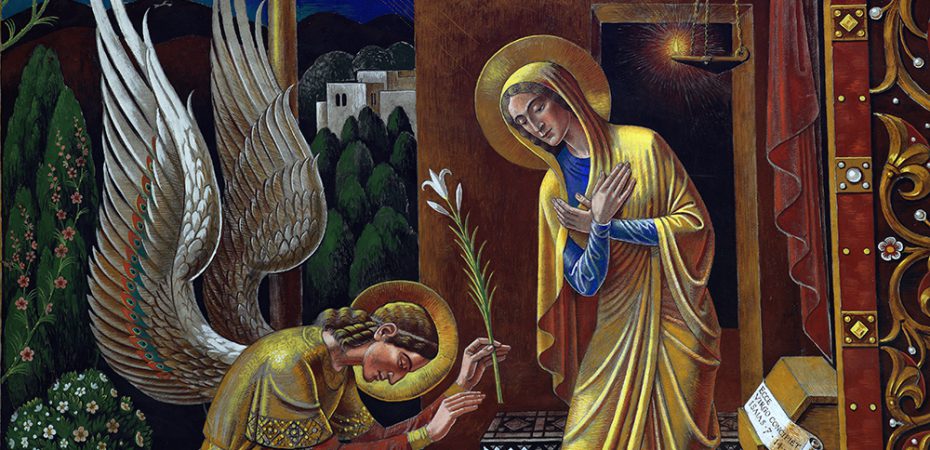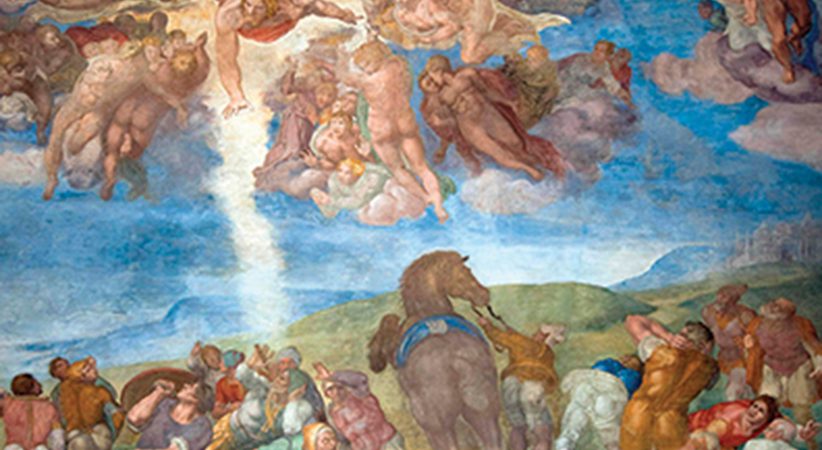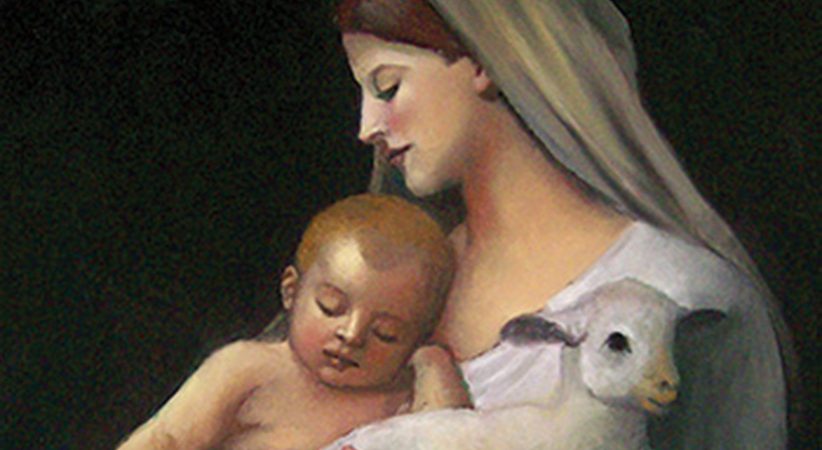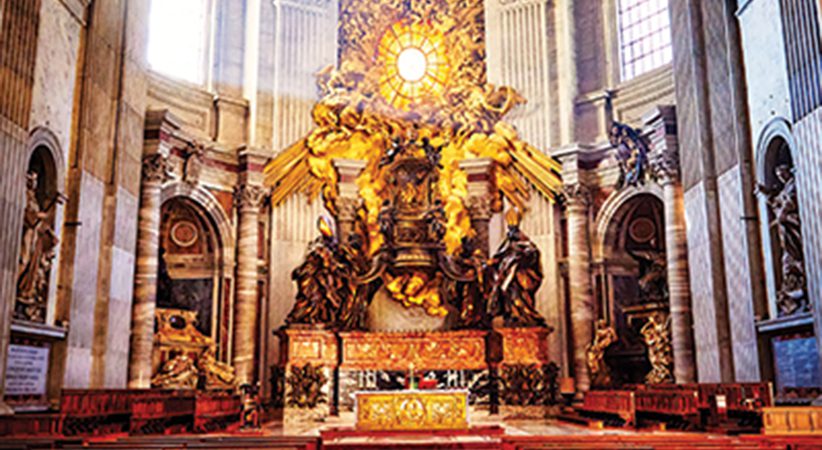How to Mirror Mary’s Heart in Priestly Ministry
Reflections upon the Virgin’s life that radiate courage and humble service
Susan Muto Comments Off on How to Mirror Mary’s Heart in Priestly Ministry
Mary is the ideal model for priestly ministry. Our Blessed Mother lives a hidden life of humble service; she manifests tender care for her son from Bethlehem to the foot of the cross; she has the courage to be his first disciple. She represents the fully human, fully spiritual person every man of God desires to be. To emulate her life offers priests a priceless opportunity to let her attitudes and actions radiate through them to the faithful who seek to follow Jesus in their own Nazareths of everydayness.
Mary’s love is a moving force. It flows like a river from festive days in parish churches to apparitions that span the globe. This woman clothed in the sun occupies a special place in the heart of every priest. By his preaching and presence, with words and without them, he strives to mirror in his priestly vocation her call to mother the Son of God.
Annunciation
“Behold, I am the handmaid of the Lord. May it be done to me according to your word” (Lk 1:38).
In this awesome moment of the visit by the angel Gabriel, Mary experienced, as any young virgin would, a commingling of fear and joy: fear of the unknown, and joy because of the promise made to her.
The same emotions that stirred Mary’s heart move the heart of every priest. He, too, fears, as any human being does, what the Lord may ask of him, and yet he rejoices for having been chosen to preside in the person of Christ at the altar of consecration. Knowing his life story as well as he does, a priest may wonder how this can be while believing, as Mary did, that “nothing will be impossible for God” (Lk 1:37).
A priest, moved to share his “annunciation” moment, said: “I recall how I felt when I learned that my mother was pregnant with her second baby, my sister. I felt dumbfounded when she put my hand on her stomach and explained the mystery of love and new life in words a 7-year-old could grasp. I felt part of some greater miracle beyond my understanding. She held the silence for a while and then asked me to pray with her the first Mystery of the Rosary. This memory never leaves me. Its announcement still fills me with awe, perhaps because it points to the hidden meaning of God’s plan behind even the simplest revelation of reality.”
Mary’s response to the divine will is innocent in its immediacy, but her yes to God represents the essence of courageous receptivity. In the most unassuming way, she opens herself to the plan of salvation conceived in her womb by the power of the Holy Spirit. Her openness to God’s will is a virtue every priest seeks to cultivate.
Visitation

“And how does this happen to me, that the mother of my Lord should come to me?” (Lk 1:43).
Mary’s love for others prompts her to visit her cousin Elizabeth, who, in her old age, finds herself with child. They share a depth of trust so complete that already in the womb their children leap for joy. Together they ponder the mystery and majesty of God. From their encounter, more lessons about priestly ministry can be learned.
Priests share in the meaning of Mary’s visitation to Elizabeth each time they convey to needy souls the secret of how much they are loved by God. They visit God’s people on levels of meaning above and beyond any superficial chitchat or coffee-and-cookie get-together.
The confession of sins in a climate of total confidentiality opens hearts to conversion and trust in God. Priests mirror Mary when they baptize a child and invite those gathered around the font to ponder the wonder and sanctity of birth; when they visit the sick and share with them the kind of motherly affection Mary always displayed. There is no better way to reveal Mary’s presence in priestly ministry than to convey her unconditional love for every soul entrusted to their care.
Nativity
“Do not be afraid; for behold, I proclaim to you good news of great joy that will be for all the people” (Lk 2:10).

In the life of Mary, no day could have been more awesome than that of the birth of her son, Jesus, the savior of the world.
Like the events of the Annunciation and the Visitation, the Incarnation invites priests to reflect on the awesome question of what it means to give birth to the Word in their soul. Is the core of their being a dwelling place from whence the Word may be born anew in the hearts of the People of God?
In this most memorable of all beginnings, priests may see the birth of Jesus as an occasion for them to gather together the many moments of their life that have led to the fullness of their vocation, from the time they heard the call of the Lord and embodied it in their ministry. The birthday of the Lord offers priests a perpetual reminder of their call to participate in the Great Commission to bring the Gospel to the ends of the earth.
Presentation
“Now, Master, you may let your servant go / in peace, according to your word, / for my eyes have seen your salvation” (Lk 2:29-30).

In the Jewish tradition, it was customary for parents to offer their child to the Creator whose child is ultimately his. The Mother of God felt in no way exempt from this custom. In presenting her child at the Temple, she felt stirred in the depths of her being by the reality of her situation and the suffering she would have to undergo. She obeyed this ancient custom out of respect for the traditions of her times but, most of all, because she desired to hear God speaking to her heart through the events of loss and sorrow no disciple, not even Mary, could escape.
God calls priests to follow Jesus in the persons, events and things of daily life freed from temptations to pride, over-attachment to possessions and any form of illicit self-gratification. Being priests of God leaves them with no choice but to do what God asks of them.
Though they are likely to fail many times in this effort to listen to the invitations they receive from God, they can rely on Mary to help them live their call with humility, detachment and charity. Their heart may be a veritable battlefield, but their best defense against the Great Deceptor is to call upon Mary and to be as present as she was to the teachings of her faith tradition.
Receptive surrender to God is Mary’s gift to humanity. Like her, priests listen to reality in a gentle, not a grasping or domineering way; they are humble enough to accept their own and others’ limitations. They exhibit personal grace and magnanimity of heart, especially when they turn the most insignificant act of service into a means of giving glory to God.
Finding in the Temple
“And all who heard him were astounded at his understanding and his answers” (Lk 2:47).
This mystery invites one to recall another event in Mary’s life, the day she knew the time had come to return her child to God. Her son had to be about his Father’s business. Not being able to find him for a while symbolized for Mary and Joseph that he would eventually have to leave their care in Nazareth and make his way in the world. Despite the truth he taught and the miracles he performed, he would be betrayed by a friend and subject to undergoing a violent death. God took Mary’s child away for a purpose she could only dimly foresee in those early days, and yet she gave him up because she believed in God’s promise despite the sword that would pierce her heart.

A priest had to convey the sad news to his congregation that the only child of a couple in the parish had been killed in a hit-and-run accident. Though his father and mother were devastated, angry and distraught, he asked them if they had lost all hope. Their reply was not what he expected. They told him that this child was not only theirs but God’s. God did not will this death; it happened and somehow they had to find the faith to see its meaning in the context of God’s never-failing love for them and every parent on earth.
Mary’s finding of her child and her surrendering of him to God confronts priests with a question close to the heart of every mother and father. What belongs to them and what is and forever will belong to God? Mary felt pain, but greater than this hurt was her willingness to give her all to God and to accept God’s plan for Jesus. Mary knew the difference between true and false love, between relinquishment and the foolishness of believing human beings are in control. She dearly loved Jesus, but that did not stand in the way of her hearing with love her son’s explanation, “Did you not know that I must be in my Father’s house?” (Lk 2:49).
…………………………………………………………………………………………………………………………………………………………..
A Time For Special Prayers
“Because the month of May is a powerful incentive to more frequent and fervent prayers, and because our petitions more readily find access to her compassionate heart during it, it has been a favorite custom of our predecessors to choose this month, dedicated to Mary, for urging the Christian people to offer up public prayers whenever the needs of the Church demanded it or some grave crisis threatened the human race. This year, venerable brothers, we in turn feel compelled to call for such prayers from the whole Catholic world. Looking at the present needs of the Church and the status of world peace, we have sound reasons to believe that the present hour is especially grave and that a plea for concerted prayer on the part of all Christians is a matter of top priority.”
— Mense Maio, encyclical of Pope Paul VI on prayers during Mary for preservation of peace, No. 3
…………………………………………………………………………………………………………………………………………………………….
Just as Mary found that she had to release her child to the plan the Father had designated for him, so every priest has to allow himself to be led from a worldly understanding of what it means to follow Jesus to a sacrificial willingness to carry the cross. Jesus attained power in powerlessness. Priests must ask themselves if they are ready to do the same.
Mary obeys, not because she thinks her yes will shield her from the consequences of total surrender, but because she has absolute faith in the Divine Will. Her fiat enables Mary, who is full of grace, to be a perfectly tuned instrument of God. To emulate her life is the surest way for priests to allow their life to be attuned to the celestial music orchestrated by God for the good of humankind.
The Wedding Feast at Cana
“Do whatever he tells you” (Jn 2:5).

AdobeStock
An incident in John’s Gospel that teaches followers of Jesus the true meaning of discipleship is the wedding feast at Cana in Galilee. Mary communicates what needs to be done without saying more than a few words. Her actions display the fruits of listening to God the Father by simply doing what God the Son tells them through the power of God the Holy Spirit.
When priests embody the attributes Mary so perfectly represents, the faithful see “something” of the Lord in their eyes, in the warmth of their smile, and in the love they feel for the least of them.
They may never be able to define exactly what they see, but they deeply appreciate being in the presence of priests who have chosen Mary as their model for ministry. They convey the assurance that she will bring the People of God through the joys and sufferings, the promises and pains life asks them to bear, all the while leading them: “For the Lamb who is in the center of the throne will shepherd them / and lead them to springs of life-giving water, / and God will wipe away every tear from their eyes” (Rv 7:17).
SUSAN MUTO, Ph.D., is dean of the Epiphany Academy of Formative Spirituality in Pittsburgh and author of “Gratefulness: The Habit of a Grace-Filled Life” (Ave Maria Press, $15.95).
………………………………………………………………………………………………………………………………………………………….
Praying the Rosary in the Month of May
Last year, during the depths of the COVID-19 pandemic, Pope Francis issued a letter, which he addressed to all the faithful throughout the world. He noted: “I want to encourage everyone to rediscover the beauty of praying the Rosary at home in the month of May. This can be done either as a group or individually; you can decide according to your own situations, making the most of both opportunities. The key to doing this is always simplicity, and it is easy also on the internet to find good models of prayers to follow.”
In his letter, he added, “Contemplating the face of Christ with the heart of Mary our Mother will make us even more united as a spiritual family and will help us overcome this time of trial.”
………………………………………………………………………………………………………………………………………………………….





